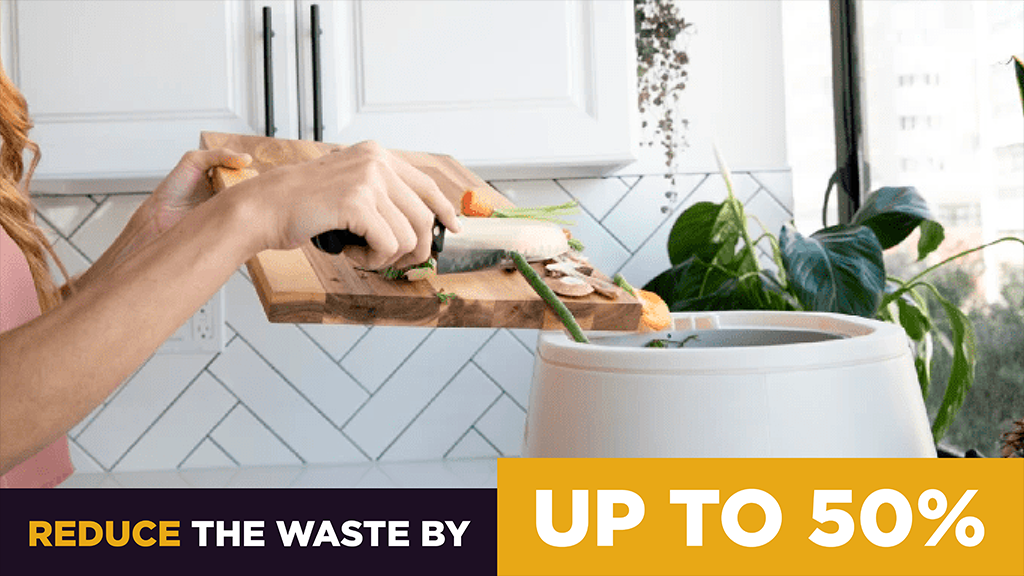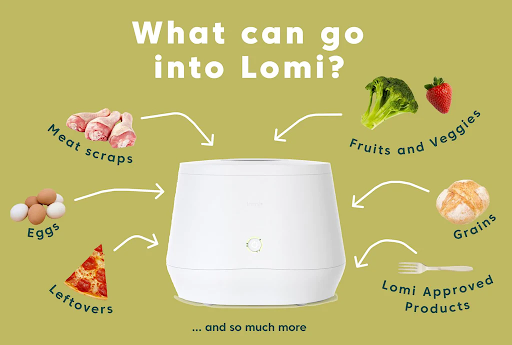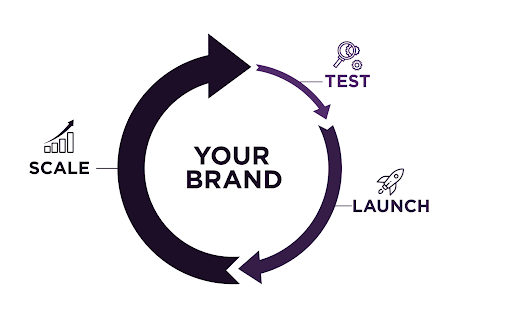How the Lomi Indiegogo Campaign Raised $7,228,029

Meet the kitchen appliance that can do in under 24 hours what nature does in five to six months.
Lomi is a one-button countertop composting machine that has revolutionized waste management.
Lomi converts waste foods and even bioplastics to natural fertilizer in one day. It allows you to turn household food waste into compost without the mess, smell, or time it takes for a regular composter to do its thing.
What’s more, using Lomi for a year will help you prevent emissions that are the equivalent of:
- Burning 257 pounds of coal
- Charging your smartphone 28,221 times
- Powering a gasoline car for 927 kilometers
“We’re on a mission to leave the planet better than how we found it by eliminating more than 10 Billion pounds of waste.”
—Lomi
See the Indiegogo project here.
About the Founders
Lomi is the brainchild of Jeremy Lang, a visionary with a deep-seated commitment to environmental sustainability.
Jeremy’s transformative journey began in 2008 during a family vacation in Hawaii.
Confronted with the devastating impact of plastic on our oceans, he dedicated his life to discovering sustainable alternatives to everyday plastic products. His relentless pursuit culminated in the foundation of Pela phone cases in 2011.
Working from the garage of his home in Saskatchewan, Jeremy introduced the world’s first compostable phone case to the market.
The innovative product was a resounding success. Today, nearly two million people have switched to Pela.
In 2018, Pela expanded its material science department and established its headquarters in Kelowna, British Columbia.
With a renewed focus, the team turned its attention to another critical area of waste — food waste. This combination of science, innovation, and creativity sparked the initial concept of Lomi, laying the foundation for a revolutionary solution to food waste management.

Our Process at LaunchBoom
At LaunchBoom, we love launching products in the green technology category. It’s one of the fastest-growing categories, and we’re in the thick of it.
As of July 2023, Indiegogo’s Energy & Green Tech category has over nine campaigns that have raised over $4 million.
Lomi’s campaign stands out for having raised over $7 million so far with the help of the LaunchBoom system.
In just 14 days, we managed to garner over 26,000 leads for the campaign, resulting in a 6.67X return on ad spend (ROAS).
So, how did we do it? Here is our process:

- Image representation of Test. Launch. Scale. Framework
Stage 1: Test Phase
The Test phase is the foundation of our approach. This stage focuses on validating the demand for a product during prelaunch.
We do this by testing the product positioning and audience targeting before launching it on a crowdfunding platform.
The idea behind this approach is simple: the ability to test product ideas inexpensively, swiftly, and accurately minimizes risk and ensures we launch market-aligned products.
This phase fits into our “Test. Launch. Scale.” framework, designed to be self-sufficient and fully capable of scaling your business.
Alt: LaunchBoom’s Test. Launch. Scale. framework
Without the Test phase, your crowdfunding campaign risks failure. Why? Because you don’t know if the market needs your product.
The question here is how do you predict your campaign’s success before launching?
We found the answer lies in testing. We evolved our strategy to test the product in the market before launching to ensure viability, significantly reducing the risk.
We call this system the TestBoom.
The TestBoom process includes the following:
- Developing initial hypotheses on how your product should be positioned in the market.
- Testing advertisements and landing pages that utilize your hypotheses.
- Analyzing the data from advertisements to learn which positioning resonates the best with your target audience.
Test Phase for the Lomi Campaign
Pela, Lomi’s parent company Pela, came to us with a strong foundation of creative assets and messaging.
However, we didn’t just take these assets at face value. We still tested to see which of their materials worked best.
We also prepared more creative assets for this campaign to supplement what Pela already had. We took what they had and added our touch to it, ensuring we had a full set of top-notch promotional materials.
Now, we partnered with Lomi in February, and the launch was scheduled for April 20, 2021, so we did the test phase at an accelerated rate because they had amazing metrics from the start.
Stage 2: Prelaunch
The Prelaunch phase acts as the bridge between the initial preparation and the final launch.
During this stage, we focus on drumming up interest and building a committed community of potential backers.
Three things go into this stage:
- Finalizing product positioning
- Scaling your reservation funnel
- Building and nurturing your community
Product Positioning
Our CEO Mark Pecota says, “When I tell people 59.9% of all crowdfunding campaigns fail, most are shocked and then immediately ask why. My answer is that they didn’t position their product correctly.”
Product positioning is how you define your product, what it does, and how it is unique in the marketplace.
It’s about how you want your potential customers to perceive your product.
When it comes to Lomi, its product positioning was clear, compelling, and addressed a real problem.
- We positioned Lomi as a revolutionary countertop composting machine that could quickly and efficiently turn food waste into compost.
- We touted Lomi as an innovative, green solution for the food waste issue faced by many households.
- This positioning appealed to the growing environmental consciousness of consumers seeking practical ways to reduce their carbon footprint.
Building Your Reservation Funnel
This is where potential backers “reserve” their spot to support your project when it launches.
This idea is to obtain a commitment, however small, from potential backers. Even a $1 pledge is a tangible indicator of their intention to support the campaign once it goes live.
See, everyone can build a reservation list. But the question is, how qualified is the reservation list? How likely are those people on the list to buy your product?
We came up with a process to ensure we get a qualified list. Here is how it goes:
Step 1: Initiation – Facebook Ad
This first step aims to draw in potential backers and lead them to the landing page using Facebook/Instagram ads.
For example, for the Lomi campaign, we did this by showcasing the compelling features of Lomi, its unique value proposition, and the potential environmental impact of using the product.
Step 2: Landing Page Signup
The potential backer is directed to a landing page where the main call-to-action is for them to provide their email address.
This action shows their interest and lets us notify them when the campaign goes live.
The landing page for the Lomi campaign was visually appealing and informative, further igniting the interest of potential backers.
Step 3: Reservation Bridge
After the backers provide their email addresses, we thank them and present an exclusive offer — the opportunity to become a VIP by placing a $1 deposit.
We refer to this step as the “Reservation Bridge.” It serves to deepen the commitment of the potential backer.
It’s important to note that we don’t include a checkout on this page, as it could be viewed as overly promotional and potentially off-putting. Instead, it’s a gentle nudge toward a deeper level of commitment.
Step 4: Reservation Checkout
Now, if the potential backer decides to become a VIP, they are taken to a checkout page where they complete their $1 reservation.
This final step confirms the backer’s commitment and makes them a part of the campaign’s VIP community.
People on the VIP list are 30 times more likely to purchase when we launch than Non-VIPs.
The reservation funnel helps gauge the interest and commitment of potential backers. It also allows us to optimize the ad campaigns.
By tracking those who make the $1 deposits, we can enhance our ad strategies, which, in turn, further fuels the campaign’s success.
How did we handle the Prelaunch stage for Lomi?
For the Lomi campaign, this is how much we used for the pre-campaign to get a pre-qualified reservation list:
| Ad spend | $84,667.31 |
| VIPs on the reservation list | 3,712 |
| Conversion Rate | 34.64% |
| Direct revenue from the reservation list | $564,694.00 |
| Return on ad spend | 6.67X |
We used this budget for two weeks.
Our tactics weren’t merely to spend on ads; instead, we utilized two expert methods to maximize results.
-
Campaign Budget Optimization
Campaign Budget Optimization (CBO) is a powerful tool provided by Facebook for advertisers.
It uses advanced algorithms and learning to optimally distribute your ad campaign budget across the various ad sets to achieve the best results. It shifts spending in real-time to high-performing ads, thus maximizing the impact of your ad budget.
In the case of the Lomi campaign, we utilized CBO to drive a high return on ad spend. By allowing Facebook’s machine learning algorithms to automatically adjust the budget based on ad performance, we could ensure that the campaign funds were being allocated most effectively.
This strategy helped ensure we reached a broad yet targeted audience, increasing the campaign’s overall visibility and efficiency.
Expert Tip: CBO is typically more effective for larger budgets. If your total campaign budget is relatively small, dividing it among multiple ad sets may result in each ad set not receiving enough budget for the algorithm to learn and optimize.
-
Cost Cap
Cost Cap is an advanced bidding strategy designed to help you maximize your cost efficiency while scaling spend.
Simply put, Cost Cap is a spending strategy that allows you to set a maximum cost per action (CPA). Facebook will aim to get as many conversions as possible without exceeding this cap.
By setting a Cost Cap for the Lomi campaign, we established an upper limit to the amount we were willing to pay for a conversion (in this case, for gaining a VIP reservation).
We set the cost cap to $25 for a $1 reservation.
Expert Tip: Cost Cap, like any other bidding strategy, should be used wisely. It’s most effective when you clearly understand your conversion metrics and can accurately predict the cost per action that will deliver profitable results.
Talk to our experts at LaunchBoom to help you set up the campaign budget optimization and the cost cap.
These two strategies gave us total direct revenue of $564,694 in just two weeks.
Stage 3: Launch Stage
The Launch Stage is the culmination of all the preceding efforts, when all the buzz we created during the Test and Prelaunch Phases is released to the public. It’s when your product finally goes live on the crowdfunding platform.
This is when the actual crowdfunding campaign takes place. All VIPs and backers can now finally contribute to your campaign and claim rewards.
At LaunchBoom, we always aim to have a strong first day. We call this having a LAUNCHBOOM. We aim to get fully funded in the first 24 hours.
A strong first day gives your campaign momentum to carry on throughout the funding period and even after.
The first step in the launch phase is to email your community (this includes the VIPs and interested people who left their emails on the landing page).
These are the people that will set the momentum for your campaign. So be persistent in this email strategy.
Now, we don’t stop there. During the launch phase, we get into live campaign advertising. As the norm, we use Facebook/Instagram advertising.
Live Advertising
We use live campaign advertising to leverage the already-built momentum and press to further amplify our campaign reach.
During this period, we developed a targeted advertising strategy to engage with new audiences who may not have encountered the prelaunch campaign ads.
TIP: At this stage, we also retarget leads and VIPs that didn’t back the campaign.
Facebook/Instagram is an effective platform due to its wide reach and sophisticated targeting capabilities.
We use the data from our advertising efforts to fine-tune our ads and targeting approach.
We also use closing strategies as a final push to motivate potential backers to take action:
- A countdown
- Special offers
- Final reminders
- Stretch goals
These strategies create a sense of urgency and induce the “fear of missing out” (FOMO) in potential backers.
For the Lomi campaign, this was the ad budget for the live campaign.
| Live Ad Spend | $57,985.38 |
| Live Ad Revenue | $276,542 |
| Live Return on Ad Spend | 4.77X |
Almost 5X return on ad spend. Exceptional!
Stage 4: Post-Campaign
The post-campaign stage is just as important as the previous stages and requires strategic planning and careful execution.
The stage is centered around three key activities:
- Delivering the promised product or service
- Maintaining the community you’ve built during the campaign
- Preparing for future campaigns or scaling the business
One thing that takes center stage during the post-campaign stage for projects on Indiegogo is transitioning into the InDemand program.
Indiegogo InDemand is a feature that allows you to continue raising funds after your campaign ends. It keeps your project open to new backers and maintains the momentum gained during the campaign.
This transition into InDemand provides an additional source of revenue, allows you to reach a larger audience, and keep your community engaged as you move from campaign to delivery.
In total, the Lomi campaign raised over $7,228,029.
Future Success
The forward momentum gained from a successful launch can propel not just a single product but an entire brand or suite of products.
At LaunchBoom, we’re thrilled to walk alongside innovators as they develop and introduce new products and even entirely new concepts to the market.
As Mark sums it up: “Every successful campaign is not just a one-off event; it’s the foundation of a sustainable and scalable brand. The success of one campaign has a ripple effect, enabling the launch of new products, opening doors to further opportunities, and attracting more resources for growth.”
Lessons Learned
- Prepare beforehand – Having all the creative assets ready before the launch expedites the process and lets us focus on building a solid prelaunch strategy and a qualified reservation list.
- Don’t skip the prelaunch – Even when working with a tight timeline, avoid the temptation to launch without a robust prelaunch phase.
- Use advanced advertising strategies – Optimal utilization of tools like Facebook’s Campaign Budget Optimization (CBO) and Cost Cap lets you maximize your return on ad spend.
Conclusion
The success of the Lomi campaign shows the importance of a comprehensive, strategic approach when launching a crowdfunding campaign.
Our experience with Lomi also reaffirms the importance of having a well-tested process and continually refining it based on the lessons learned along the way.
So, are you planning to launch a product or looking for strategies that can guarantee success? At LaunchBoom, we’re always ready to support you with tested and proven strategies that ensure a successful product launch. Talk to us today.
Related Campaigns
Looking to learn the secrets behind Lomi’s $7M+ raise on Indiegogo? We recommend watching this episode of Masters of Crowdfunding featuring Lomi’s Gareth Everard:

